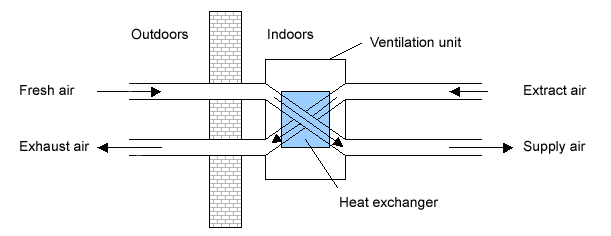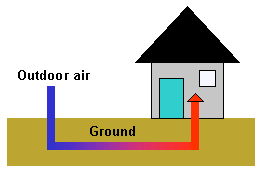
Ventilation
The indoor air quality in buildings is an important factor for the occupants well-being. Therefore, it is indispensable to supply the building with "fresh air", especially when the building possesses an airtight envelope. The ventilation behaviour of the residents often depends on the personal sense. This must not necessarily correspond to the results of objective measurements the air composition. This can be defined as air quality indicators.
Attributes of good air
Usually the air quality of a room is determined by its CO2 concentration, especially if human emissions are responsible for the load of indoor air. Insufficient ventilation can cause tiredness, lack of concentration or headache. This is not generally caused by anoxia but by a too high CO2 concentration. The CO2 concentration of outdoor air averages 360 ppm (vol.). In closed and occupied rooms the limit should not exceed 1000 ppm (vol.). Converting the maximum concentration into the required air exchange rate one gets a fresh air volume rate of 37 m³/h (based on the metabolism of resting person). Today, in general a fresh air volume rate of 30 to 40 m³/h is used for the design of ventilation systems in housing construction.CO2 sensors can be used for a need-regulated ventilation.
A further parameter of indoor air quality is the humidity. Cooking, taking a shower, cleaning, persons and plants increase the indoor water vapour content. In contrast to CO2, a high concentration of vapour worsens not only air quality but can also cause building deficiencies by convective and diffusive penetration into the building envelope. In conjunction with thermal bridges mould grows. Particularly in connection with high temperatures, a humidity produces persperation and problems with the cardiovascular system. Humid indoor air climate favours the grows of mites and mould. Its spores can provoke allergies. Dry air has no negative effects on the building structure, but the occupants might get dry mucous membranes. The recommended relative humidity lies between 35% and 60%.
Substances, which might pollute indoor air are:
Possibilities of ventilation
To guarantee a good indoor air quality it is necessary to remove the "consumed air" (exhaust air) and to supply "fresh air" (supply air). The different kinds of air infiltration are shown in the following figure.
 |
| Figure 1: The possible kinds of ventilation are versatile [1]. At any rate the concept of the ventilation should be adjusted to the remaining building services. |
Pressure differences are the physical reason of each flow and therewith of the air exchange. They can be produced by fans for mechanical ventilation or by natural driving forces for "natural" ventilation.
Natural ventilation
Natural ventilation has to be distinguished from intended natural ventilation and unintentional natural ventilation. In both cases the driving forces for air exchange are caused by differences in temperature and the wind field. Intended natural ventilation results from:
Especially shock ventilation is very effective by opening two opposite windows (cross ventilation). The frequency and duration of ventilation through wind strongly depend on the personal feeling or attitude of the occupants. Therefore, it is very difficult to realise a demand oriented and optimised ventilation through windows because there is either
Unintended natural ventilation (infiltration / exfiltration) results from leakages in the building envelope (joints, leaky windows and doors, installation … ). In many old buildings the unintended natural ventilation is almost sufficient for the supply with fresh air.
As a consequence, the following disadvantages arise:
Today, the building envelope is implemented as airtight as possible. Using a controlled ventilation will lead to an optimum between good air quality and reduced ventilation heat losses, which are increasingly important as the transmission heat losses are becoming smaller due to the meanwhile high thermal insulation standard.
Mechanical ventilation
Fans produce the pressure difference, which is necessary for the air exchange. This makes it possible to control the air exchange and guarantee a hygienically indoor air quality. Mechanical ventilation units are installed in different versions (see figure 1):
Central exhaust ventilation systems are operated with one fan only, which produces a negative pressure in the ventilated section. The supply air flows from outside through leakages or holes into the ventilated section. The exhaust air is blown outside. In order to utilise the heat of the exhaust air, it can be led to heat pumps in bigger systems.
Central ventilation systems have two fans. One fan supplies the building with just the exact quantity of fresh air which the other fan extracts. In buildings, the air inlet and the exhaust openings are not necessarily installed in the same room. Insignificant differences in pressure between supply air (living room, dining room, etc.) and exhaust air section (kitchen, bathroom, etc.) transfer air from the supply zone into the exhaust zone. The warm exhaust air can be used to heat the supply air when the supply air and exhaust air volume rate is directed to one another through a heat exchanger. This recovery is called recuperative heat recovery. The different heat exchanger can be distinguished from their air ducts as parallel flow, reverse flow and cross flow heat exchanger. The different types can also be combined, e.g. to a cross reverse flow heat exchanger.
 |
| Figure 2: Schematical demonstration of the different air ducts of heat exchangers. |
Different characterisation of air:
 |
| Figure 3: The cold outdoor air is blown through the heat exchanger, warmed up by the exhaust air and injected as supply air into the ventilated room. The cooled off extract air is blown outside as exhaust air. |
Regenerative heat recovery uses the principle of heat storage. The waste heat of the extract air is stored in a buffer and transferred to the supply air later. Central ventilation units of good quality can reach a heat recovery efficiency of 90 %. Today, these central ventilation systems offer the best facilities for supplying a building with fresh air and reducing ventilation heat losses at the same time.
A clever planned duct system, which is required for the already described central ventilation systems, is not necessary for decentralised ventilation units. Therefore, they are suitable for retrofit of buildings or specific ventilation of a single room in which a high pollutant concentration or air humidity can occur. The characterised functions of exhaust air ventilation systems or central ventilation units can also be realised with decentralised ventilation units. Of course decentralised ventilation units do not attain the quite high heat recovery efficiency of central systems. In addition, unsuited exhaust and supply openings can cause short-circuit flow through unfavourable installation.
Normally, the use of mechanical ventilation systems with heat recovery is only reasonable if the building envelope is airtight, so that uncontrolled infiltration, caused by leakage, is very small. If the supply and exhaust airflow rates are badly balanced, the ventilation system puts the building under a pressure difference against outdoor conditions. Then, air may be leaking through the building envelope and increase the ventilation heat losses.
Additional options
A ventilation system can take over additional tasks. Especially in passive houses, halls and industrial buildings, the existing ventilation system is used for heating (air-heating). In passive houses the outside air, warmed up by passing the heat recovery system, is blown through a "re-heating system" and distributed in the ventilated space. The heating power can be calculated by the following equation:

One can see, that the heating power H can be increased only by an enhancement
of the airflow rate Q or the air temperature. The specific density ![]() ,
the heat capacity of air c and the inside air temperature Tspace
are given. If the airflow rate depends on the ventilation, only the temperature
can be increased. The increase of the temperature is restricted due to reasons
of comfort and air quality, because the carbonization of dust particles already
occurs at 52°C. Air heating systems are operated particularly in passive
houses, because the attainable heating power is comparatively small. The two
physical quantities Q and Tair can be varied in larger
extend, if air-heating systems are partly used in recirculating air operations
in halls and industrial plants.
,
the heat capacity of air c and the inside air temperature Tspace
are given. If the airflow rate depends on the ventilation, only the temperature
can be increased. The increase of the temperature is restricted due to reasons
of comfort and air quality, because the carbonization of dust particles already
occurs at 52°C. Air heating systems are operated particularly in passive
houses, because the attainable heating power is comparatively small. The two
physical quantities Q and Tair can be varied in larger
extend, if air-heating systems are partly used in recirculating air operations
in halls and industrial plants.
Air conditioning is attained by upgrading the air heating system with an air cooler and a moisture regulator. Thus, all air treatments like ventilating, cooling, heating, humidifying and dehumidifying can be performed. Such systems are used both as comfort units for living and work space (production of a convenient indoor climate), and, even more often, as industrial air conditioning (observance of air parameters to produce or to lodge a product).
Earth heat exchanger
An earth heat exchanger directs the outdoor air through a pipe which is installed in the ground. Thereby, a heat exchange of the air with the soil through the pipe wall takes place. The pre-heated or pre-cooled air is led into the ventilation system of the building.
 |
| Figure 4: Scheme of an earth heat exchanger. |
In winter, the cold outdoor air is pre-heated through the ground and the heating load is reduced. In summer, the warm outdoor air is cooled by the earth heat exchanger, which reduces the cooling load of the building.
Night ventilation
Night ventilation as a concept can be installed in order to reduce, or even to avoid the overheating in summer. Therefore, either natural ventilation or the mechanical ventilation can be implemented. At night, the building is ventilated with cool outdoor air in order to reduce the indoor air temperature.
Literature / references:
[1] Höptner, Swen: Messungen zum lüftungs- und wärmetechnischen Verhalten an Raumlüftungsgeräten und in Räumen - Vergleich mit Simulationen, Diplomarbeit, Dezember 2001, Siegen.
[2] Manz, H.: Schlußbericht zum Forschungsprogramm "Rationelle Energienutzung in Gebäuden" - Einzelraumlüftungsgeräte mit Wärmerückgewinnung. Eidgenössische Materialprüfungs- und Forschungsanstalt (EMPA), 1998, Dübendorf, Schweiz.
Further references:
Recknagel H., Sprenger E., Schramek E.R.(HRSG): Taschenbuch für Heizung + Klimatechnik 97/98, 68. Auflage, R. Oldenbourg Verlag GmbH,1997, Wien.
Pohl W.-H., Pohl R. und Horschler, S.: Gebäudedichtheit; VEW Energie Aktiengesellschaft (Hrsg.), Verlagsgesellschaft Flade + Partner mbH, München,1999.